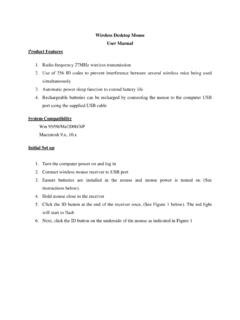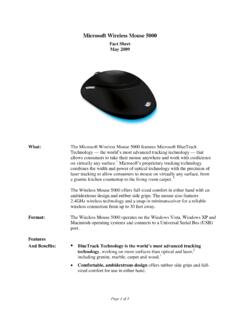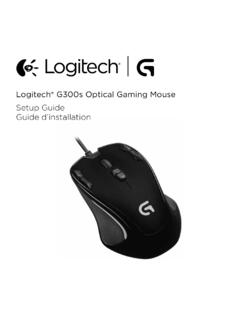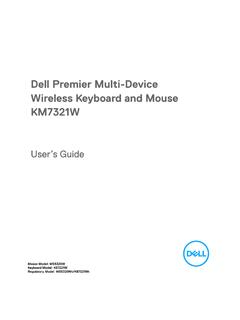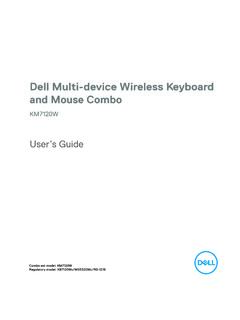Transcription of Optical Computers - University of North Carolina Wilmington
1 Optical ComputersHow They Work and Why We Will See ThemWhy We Need ThemMoore s Lawstates that the number of transistors on a computer chip doubles every eighteen transistors can no longer keep up. Too many transistors will slow down processor speeds. Transistors have physical size wires limit the speed of per unit length in the chip is being increased, causing more power usage and excess Is an Optical Computer?An Optical computer is a computer that performs its computation with photons as opposed to the more traditional electron-based are two different types of Optical Computers .
2 Electro- Optical Hybrid Computers Pure Optical computersSilicon Vs. Optical ComputersBasic Path of Information Through an Optical ComputerInformation gets sent in from keyboard, mouse , or other externalsources and goes to the processor. Processor then sends the information through logic gates and switches to be information is then sent through different fiber optic cables depending on it s final information will be sent to the holographic memory, where it will then be information is saved and the program would like to use it,the program sends a command to the processor, which then sends a command to receive the program receives the information and sends a signal back to the processor to tell it that the task is complete.
3 Electronic ComputerOptical ComputerElectro- Optical HybridUse Optical fibers and electric parts to read and direct data from the processor Light pulses send information instead of voltage change from binary code to light pulses using is then detected and decoded electronically back into Optical ComputersUse multiple frequenciesInformation is sent throughout computer as light waves and electron based systemsNo converstion from binary to Optical necessary, greatly increasing the s Optical ProcessorFirst programmable Optical processor Combines optics, silicon, communications, and tools in standard board Software tools allow smooth development pathOptical TransistorsTransistors based off of the Fabry-Perot Interferometer.
4 Constructive interference yields a high intensity (a 1 in binary) Destructive interference yields an intensity close to zero (a 0 in binary)Constructive TransistorDestructive TransistorDigital Optical Logic GatesLiquid Crystal Light Valve (LCLV) Uses a liquid crystal device and a photoconductor. Programmable through application of a write beam, causing the polarization of the reflected beam to Logic GateSelf Electro-optic Effect Device (SEED) Change in voltage changes absorption properties in quantum well layers. Stackable Small size Low power Easily made Compatible with standard fabrication techniques for current logic Optical Logic GateThis is an All Optical logic gate based on Interference fringes, which the detector reads, and then sends the information through to the correct program.
5 Optical Vs. Electrical SwitchesChange the direction of propagation for the transmitted wave. Allow information to be used in other parts of the Optical properties of materials are used to redirect the propagation of one light using another control out of direction of binary code through Switch (can choose between two directions)LAN Switch for networkingAll Optical SwitchesAnalog Gimbal-Mirror Switch Direct light into higher number of ports without much loss of information No need to waste time converting from Optical to digital.
6 Problems include; tightly packed mirrors, mirror-control algorithm, fiber and lens arrays and mechanical FibersAdvantages Small in size Low transmission losses No interference from radio frequencies, electromagnetic components, orcrosstalk Safer More secure Environmental immunityInterconnection of Optical FibersAdvantages Bandwidth independence No capacitive effects No interference between parallel waves Low power constraints Increased flexibilityDisadvantages. Cost Size Alignment precision Thermal stability Fabrication Lack of design software for creation Need ultra low voltagesHolographic MemoryA holographic memory can store data in the form of a hologram within a laser is split into a reference beam and a signal beam goes through the logic gate and receives informationThe two beams then meet up again and interference pattern creates a hologram in the MemoryAdvantages to Optical ComputingSmall sizeIncreased speedLow heatingReconfigurable Scalable for larger or small networksMore
7 Complex functions done fasterApplications for Artificial IntelligenceLess power consumption (500 microwatts per interconnect length vs. 10 mW for electrical)Limiting Factors for Optical ComputersOptical fibers on a chip are wider than electrical need 1mm of length and are much larger than current transistorsSoftware needed to design and run the Exists AlreadyBeam splitters which move light in array by silicon being placed at different with banyan switches,allowing for more programming combinationsCrossover switches which are used in digital which convert light into electrical current.
8 A Variable Electro- Optical Mirror, created by Hudson Research, Inc. How we use fiber optics nowWe currently use DWDM(dense wavelength division multiplexing) fiber optics for data transfers betweens is making fiber optics to the home available for high speed internet Spatial Filters are used for medical imaging, using Fourier Analysis to sharpen an image, such as an X-RayImages Using Optical Spatial FiltersUnfiltered ImageFiltered ImageWhat is Probable to See in the FutureOpto-electronic in natureUse direct analogy of presence or absence or signals from a lasers will be able to travel through one pathway.
9 Making the travel time within the computer much Light ModulatorsThere are six major groups. One-dimensional Optical / Optical One-Dimensional Optical / Electrical One-Dimensional Electrical / Optical Two-dimensional Optical / Optical Two-Dimensional Optical / Electrical Two-Dimensional Electrical / Optical










